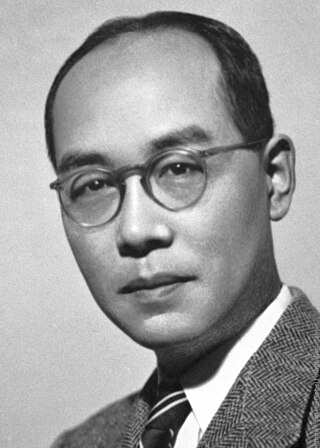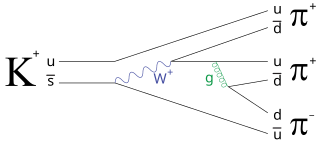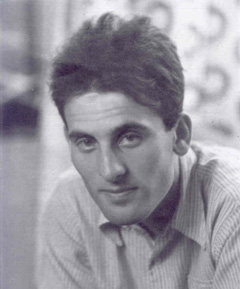Related Research Articles

In particle physics, a meson is a type of hadronic subatomic particle composed of an equal number of quarks and antiquarks, usually one of each, bound together by the strong interaction. Because mesons are composed of quark subparticles, they have a meaningful physical size, a diameter of roughly one femtometre (10−15 m), which is about 0.6 times the size of a proton or neutron. All mesons are unstable, with the longest-lived lasting for only a few tenths of a nanosecond. Heavier mesons decay to lighter mesons and ultimately to stable electrons, neutrinos and photons.

In particle physics, a pion is any of three subatomic particles:
π0
,
π+
, and
π−
. Each pion consists of a quark and an antiquark and is therefore a meson. Pions are the lightest mesons and, more generally, the lightest hadrons. They are unstable, with the charged pions
π+
and
π−
decaying after a mean lifetime of 26.033 nanoseconds, and the neutral pion
π0
decaying after a much shorter lifetime of 85 attoseconds. Charged pions most often decay into muons and muon neutrinos, while neutral pions generally decay into gamma rays.
A timeline of atomic and subatomic physics.

Hideki Yukawa was a Japanese theoretical physicist and the first Japanese Nobel laureate for his prediction of the pi meson, or pion.

A bubble chamber is a vessel filled with a superheated transparent liquid used to detect electrically charged particles moving through it. It was invented in 1952 by Donald A. Glaser, for which he was awarded the 1960 Nobel Prize in Physics. Supposedly, Glaser was inspired by the bubbles in a glass of beer; however, in a 2006 talk, he refuted this story, although saying that while beer was not the inspiration for the bubble chamber, he did experiments using beer to fill early prototypes.

The tau, also called the tau lepton, tau particle, tauon or tau electron, is an elementary particle similar to the electron, with negative electric charge and a spin of 1/2. Like the electron, the muon, and the three neutrinos, the tau is a lepton, and like all elementary particles with half-integer spin, the tau has a corresponding antiparticle of opposite charge but equal mass and spin. In the tau's case, this is the "antitau". Tau particles are denoted by the symbol
τ−
and the antitaus by
τ+
.

In particle physics, a kaon, also called a K meson and denoted
K
, is any of a group of four mesons distinguished by a quantum number called strangeness. In the quark model they are understood to be bound states of a strange quark and an up or down antiquark.

Carl David Anderson was an American physicist. He is best known for his discovery of the positron in 1932, an achievement for which he received the 1936 Nobel Prize in Physics, and of the muon in 1936.

Cecil Frank Powell, FRS was a British physicist, and Nobel Prize in Physics laureate for heading the team that developed the photographic method of studying nuclear processes and for the resulting discovery of the pion (pi-meson), a subatomic particle.

Jack Steinberger was a German-born American physicist noted for his work with neutrinos, the subatomic particles considered to be elementary constituents of matter. He was a recipient of the 1988 Nobel Prize in Physics, along with Leon M. Lederman and Melvin Schwartz, for the discovery of the muon neutrino. Through his career as an experimental particle physicist, he held positions at the University of California, Berkeley, Columbia University (1950–68), and the CERN (1968–86). He was also a recipient of the United States National Medal of Science in 1988, and the Matteucci Medal from the Italian Academy of Sciences in 1990.
The ring-imaging Cherenkov, or RICH, detector is a device for identifying the type of an electrically charged subatomic particle of known momentum, that traverses a transparent refractive medium, by measurement of the presence and characteristics of the Cherenkov radiation emitted during that traversal. RICH detectors were first developed in the 1980s and are used in high energy elementary particle-, nuclear- and astro-physics experiments.

Cesare Mansueto Giulio Lattes, also known as César Lattes, was a Brazilian experimental physicist, one of the discoverers of the pion, a composite subatomic particle made of a quark and an antiquark.

Giuseppe Paolo Stanislao "Beppo" Occhialini ForMemRS was an Italian physicist who contributed to the discovery of the pion or pi-meson decay in 1947 with César Lattes and Cecil Frank Powell, the latter winning the Nobel Prize in Physics for this work. At the time of this discovery, they were all working at the H. H. Wills Laboratory of the University of Bristol.
The timeline of particle physics lists the sequence of particle physics theories and discoveries in chronological order. The most modern developments follow the scientific development of the discipline of particle physics.
A nuclear emulsion plate is a type of particle detector first used in nuclear and particle physics experiments in the early decades of the 20th century. It is a modified form of photographic plate that can be used to record and investigate fast charged particles like alpha-particles, nucleons, leptons or mesons. After exposing and developing the emulsion, single particle tracks can be observed and measured using a microscope.

Donald Hill Perkins was a British physicist and an emeritus professor at the University of Oxford. He achieved great success in the field of particle physics and was also known for his books.

Debendra Mohan Bose was an Indian physicist who made contributions in the field of cosmic rays, artificial radioactivity and neutron physics. He was the longest serving Director (1938–1967) of Bose Institute. Bose was the nephew of the famous physicist Jagadish Chandra Bose, who laid the foundations of modern science in India.
Hugh Muirhead was a British nuclear physicist and the last surviving author of the scientific paper announcing the discovery of the pion, a particle predicted by Hideki Yukawa.
Estrella A. Mazzoli de Mathov was an Argentinian physicist who was instrumental to cosmic ray research in Buenos Aires in 1949.
Rosemary Fowler is a British physicist who contributed to the discovery of the kaon. She was one of the first women to graduate with first class honours from the University of Bristol.
References
- ↑ Tong, David. Particle Physics. CERN Lectures. pp. 62–63.
- ↑ Owen Lock (June 1997). "A Century and its Half" (PDF). CERN Courier. 37 (5): 4.
- 1 2 "In the footsteps of Cecil Powell". physicsworld.com. 14 September 2017. Retrieved 12 January 2024.
- ↑ Luisa Bonolis (17 June 2015). "Cecil Frank Powell". www.mediathequ.lindau-nobel.org. Retrieved 2 June 2021.
- ↑ Lattes, Dr.C.M.G.; Muirhead, H.; Occhialini, Dr.G.P.S.; Powell, Dr.C.F. (24 May 1947). "Processes involving charged mesons". Nature. 159 (5): 694–7. Bibcode:1947Natur.159..694L. doi:10.1038/159694a0.